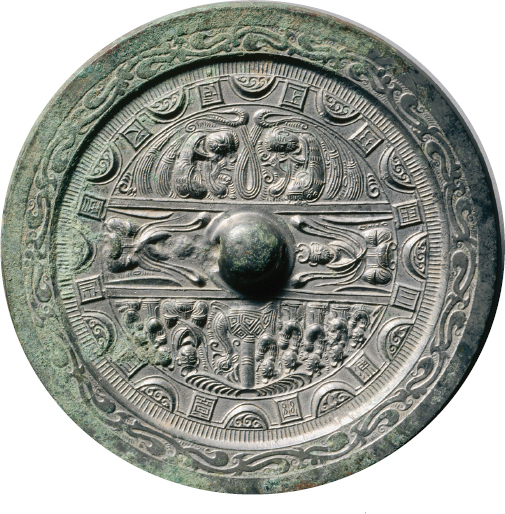Understanding World Societies:
Printed Page 178
Han Intellectual and Cultural Life
In contrast to the Qin Dynasty, which favored Legalism, the Han came to promote Confucianism. The Han government’s efforts to recruit men trained in the Confucian classics marked the beginning of the Confucian scholar-
However, the Confucianism that made a comeback during the Han Dynasty was a changed Confucianism. Although Confucian texts had fed the First Emperor’s bonfires, some dedicated scholars had hidden their books, and others had memorized whole works. The ancient books recovered in this way — called the Confucian classics — were revered as repositories of the wisdom of the past. Confucian scholars treated these classics with piety and attempted to make them more useful as sources of moral guidance by writing commentaries on them.

The backs of bronze mirrors were frequently decorated with images of deities and animals and with auspicious words. As viewers turned the mirrors, they saw different scenes. This Han mirror features an outer border with semicircles decorated with cloud patterns and squares with words written on them. In the center are deities. (Mirror Featuring Deities and Kings in Three Sections Surrounded by Rings of Squares and Semicircles [bronze]. Eastern Han Dynasty [25-
A major intellectual accomplishment of the Han Dynasty was history writing. Sima Qian (145–
For centuries to come, Sima Qian’s work set the standard for Chinese historical writing, although most of the histories modeled after it covered only a single dynasty. The first of these was the work of three members of the Ban family in the first century C.E. (See “Individuals in Society: The Ban Family.”)
The circulation of books like Sima Qian’s was made easier by the invention of paper, which the Chinese traditionally date to 105 C.E. Scribes had previously written on strips of bamboo and wood or rolls of silk. Cai Lun, to whom the Chinese attribute the invention of paper, worked the fibers of rags, hemp, bark, and other scraps into sheets of paper. Paper, thus, was somewhat similar to the papyrus made from pounded reeds in ancient Egypt. Though much less durable than wood, paper was far cheaper than silk and became a convenient means of conveying the written word.